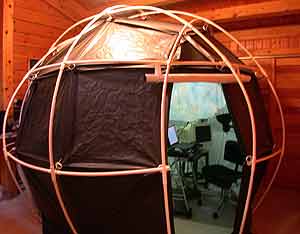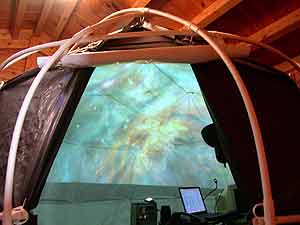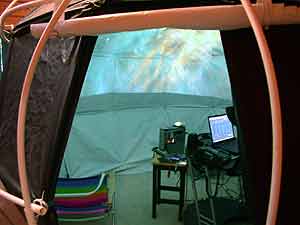The LarryDome
| In 2004, we installed The LarryDome, named in honor of our world-famous feline and star of the show Larry Cat In Space. In 2012, we sold it, and upgraded to The PixelDome. We've kept this page as a legacy reference. |
For years here at Loch Ness Productions, we created slide-based planetarium shows, programming them using banks of slide projectors shining on flat screens in our visual studio. But, when we moved into fulldome show production, it quickly became obvious we would need to have an actual dome — a 3D space we could use as a "monitor" when developing our shows.
When you're looking at a circle on a computer screen, it's not always easy to judge how that dome master is going to translate onto the curved 3D space of the dome. Small images on the monitor can seem enormous when overhead; straight line translation motions look very strange on the inside of a sphere, and objects tilted and rotated to appear "normal" can come out looking way out of whack. For our purposes, the dome didn't need to be perfect, it just needed to exist.
 Our dome choice was dictated primarily by the available space we had for it. The room with the tallest ceiling (roughly 4 meters at its highest point) also had dimensions of roughly 4 meters by 4 meters. So our dome couldn't be much bigger than 3 meters in diameter. An inflatable dome wouldn't have met our needs, even if we'd found one that small. We wanted to have it set up "permanently", and didn't want to have to crawl into it, and deal with air pressure, fan noise and all.
Our dome choice was dictated primarily by the available space we had for it. The room with the tallest ceiling (roughly 4 meters at its highest point) also had dimensions of roughly 4 meters by 4 meters. So our dome couldn't be much bigger than 3 meters in diameter. An inflatable dome wouldn't have met our needs, even if we'd found one that small. We wanted to have it set up "permanently", and didn't want to have to crawl into it, and deal with air pressure, fan noise and all.
We settled on a Shelter Systems StarBubbleTM tent. It assembled in less than an hour. The size fits our space perfectly. The price was quite reasonable too.
As you can see in the closeup (select the pics for enlargements) the supports are basic PVC pipe. Clipped to and stretched between the pipes is woven ripstop nylon. The fabric is black on one side, white on the other, and is quite opaque. Not many planetaria can roll up their entrance door!
For judging image sizes and how and where things should appear on the dome — it works just fine. You may have seen some of our fulldome shows at planetarium conferences, so you already know we've been able to make it work. If you're considering one of these for your facility, however, we should point out a couple of things that leave something to be desired.
 Perhaps the biggest drawback is the fact that it's just dome-shaped. These are stretched flat panels, not a mathematically-correct smooth spherical surface, and there are obvious seams and pucker points. We've minimized the seam gapping somewhat by lining sticky-back Velcro along all the edges, but the fabric folds are still inherent in the design. When you've been in the planetarium field for three decades, you know that stars don't really "ripple" as they move across the sky. While we can cope, those unfamiliar with such things may be less than impressed.
Perhaps the biggest drawback is the fact that it's just dome-shaped. These are stretched flat panels, not a mathematically-correct smooth spherical surface, and there are obvious seams and pucker points. We've minimized the seam gapping somewhat by lining sticky-back Velcro along all the edges, but the fabric folds are still inherent in the design. When you've been in the planetarium field for three decades, you know that stars don't really "ripple" as they move across the sky. While we can cope, those unfamiliar with such things may be less than impressed.
While having a white dome is not unusual for planetaria, this fabric is definitely white, and also has a somewhat shiny finish. What all this means is that our projected video images are really bright. In addition, we planetarians always want star fields to have a really black background. LCD projectors can't do this; you get gray. The combination of shiny white material, and the LCD projector gray gives the projected starfields a markedly un-black background on our dome.
 On the plus side, unlike in a typical portable where the projector is pretty much on the floor, the LarryDome's center is waist-high. This means we can get everything up off the floor. We easily enter and move around standing up. We can sit and work at a standard-height desk and not have our heads poking up into the projector beam. Note the control "console"; we bought this computer desk at Wal-Mart.
On the plus side, unlike in a typical portable where the projector is pretty much on the floor, the LarryDome's center is waist-high. This means we can get everything up off the floor. We easily enter and move around standing up. We can sit and work at a standard-height desk and not have our heads poking up into the projector beam. Note the control "console"; we bought this computer desk at Wal-Mart.
We have a prototype Sky-Skan definiti PD system (it's based on the elumenati's HAL-1200). The desk holds the laptop which runs DigitalSky; definiti's graphics processor CPU is outside the dome. In the top picture, you can see a monitor for it on another stool beside the console; a simple VGA A/B switch box on top of it sends the video signal to the projector when we want to see something on the dome.
The proverbial "best seats in the house" are reclining beach chairs!
Some more pix, January 2007 (courtesy
Ian McLennan)





|


